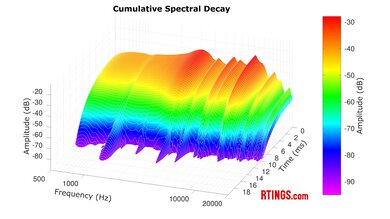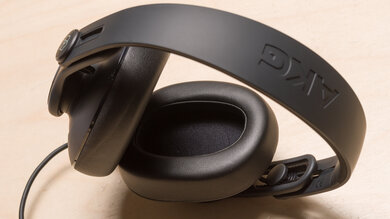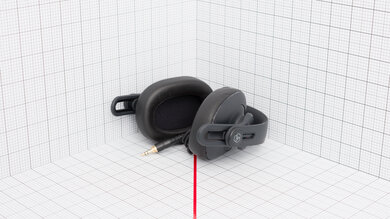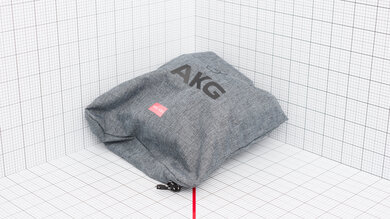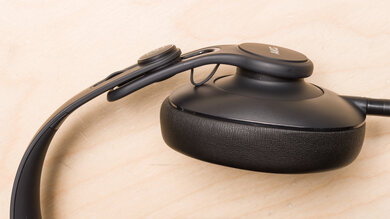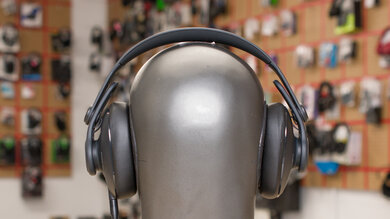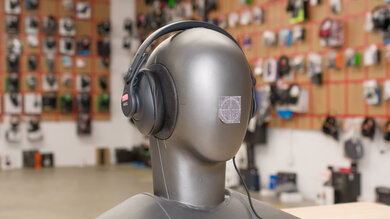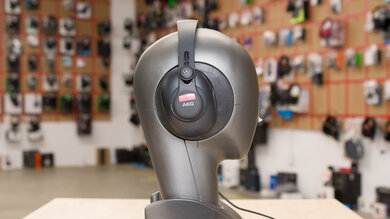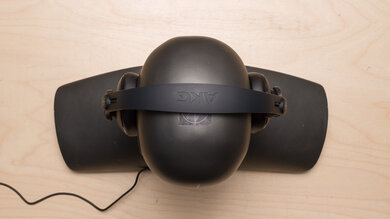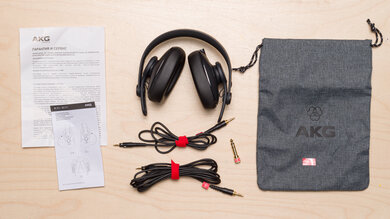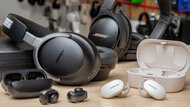The AKG K361 are lightweight, closed-back, over-ear headphones. Like their sibling, the AKG K371, they're positioned as headphones for professional studio monitoring and at an affordable price. While they do away with premium materials and stylistic embellishments found on higher-end headphones, they still deliver balanced audio with a touch of extra bass for added warmth. They're also usable with most devices without needing an amp, making them a versatile option for both casual listeners and creators on the go.
Our Verdict
The AKG K361 are sub-par for sports and fitness use. Although they're comfortable and somewhat portable (as over-ears go anyway), ultimately, these headphones aren't stable enough to handle much more than upright isometric movements. Their wired-only design isn't very practical either.
Comfortable and lightweight.
Not very stable.
Wired design is cumbersome around equipment.
The AKG K361 aren't bad for travel. As passive over-ear headphones go, they're one of the better pairs of headphones for airplanes. However, they still have poor noise isolation, so you'll still hear all the fatiguing noise and din in a cabin without the relief of active noise cancellation tech. Upsides include their folding, lightweight design with a comfortable fit. Since they don't need an amp to push them, you can plug them into most airplane entertainment systems.
Comfortable and lightweight.
Don't need a headphone amp.
Poor frequency response consistency.
Disappointing noise isolation.
The AKG K361 are poor for office work. Despite feeling lightweight and comfortable, they otherwise lack versatility. They leak audio into the office area, and they don't isolate you very well from the sounds of your workplace. While the passive design negates concerns about battery life, these headphones also lack a microphone, so you'll need a separate mic for online work meetings.
Comfortable and lightweight.
Don't need a headphone amp.
No microphone.
Poor frequency response consistency.
Disappointing noise isolation.
The AKG K361 are wired-only headphones.
The AKG K361 are acceptable for wired gaming. Your PC and consoles can drive the passive headphones without needing additional amplification. They reproduce lows with an extra dose of emphasis so you'll feel the rumble in the center of the action, though this depends: if you wear glasses, the bass is rather anemic. Mids are very flat, so dialogue sounds natural, and upper frequencies are more or less clear. Since they're decently well-matched between the L/R, you can reliably locate direction in the mix. However, they don't interact with your outer ears much, so relative distance in space isn't very obvious. They also don't include a microphone, which limits their versatility, but if you don't need one, the Audio Reproduction Accuracy section of this review is also worth a look.
Comfortable and lightweight.
Don't need a headphone amp.
No microphone.
Poor frequency response consistency.
The AKG K361 are satisfactory for audio reproduction accuracy. They comply well with our target curve with a bit of extra low-end weight and a somewhat warm top-end. They exhibit low distortion, too. However, their sound signature isn't the smoothest, due to narrow peaks and dips in the treble, their group delay reproduces a looser bass response, which affects audio fidelity. Unfortunately, the headphones' fit and seal are susceptible to variations between people's characteristics (such as long hair, glasses, and head size), resulting in either relatively weak bass or even punchier bass.
The AKG K361 have sub-par noise isolation, which isn't unexpected for passive isolating headphones. Since they're closed-backed, though, they still tame sharp, high-pitched background noises somewhat. But without the aid of active noise cancellation, they don't meaningfully filter out low rumbles or people talking.
The AKG K361 don't have a microphone.
The AKG K361 have poor frequency response consistency. It's difficult for all people to get an unbroken over-ear seal, which leads to people with long hair and glasses hearing a weak bass response compared to people with average-sized heads. These need extra attention to ensure they're perfectly sealing around your ears.
Performance Usages
Changelog
- Updated Jul 29, 2025:
We've updated the Sound Profile box with a link to a downloadable folder of EQ settings that will help you match these headphones' frequency response to different target curves available in our Graph tool.
- Updated May 20, 2025:
This review has been updated to Test Bench 2.0, which adds the following tests: Stereo Mismatch, Group Delay, Cumulative Spectral Decay, PRTF, Harmonic Distortion, and Electrical Aspects. We've added new performance usages and updated the text throughout the Sound tests.
- Updated May 14, 2025: We've converted this review to Test Bench 2.0, which updates our sound tests and adds performance usages. You can read more about this in our changelog.
- Updated Jan 31, 2025: Review published.
Check Price
Differences Between Sizes And Variants
These headphones have one variant, 'Black,' which is primarily plastic with a matte-black finish. They also have a Bluetooth variant, the AKG K361-BT, but we haven't tested whether they perform the same.
If you encounter another variant of these headphones, please let us know in the comments, and we'll update our review.
Popular Headphones Comparisons
The AKG K361 are closed-back headphones positioned as professional studio monitors that are easier on the wallet. They're a member of a continually growing class of value-oriented headphones that don't sacrifice sound quality for savings. While their sibling, the AKG K371, are similar in performance and tier, the K361 maximize on savings by cutting out external metal components and detailing, opting for a full plastic construction. The K361 also directly compete against the Beyerdynamic DT 770 PRO and trade blows in comfort and compliance to our target, but fall short in consistency between wears. In the realm of passive soundstage, however, both the AKG and Beyerdynamic are closed-back headphones and don't offer as immersive or open an experience as open-back headphones like the Philips Fidelio X2HR and Philips SHP9600.
For more recommendations, check out the best studio headphones for mixing and recording, the best audiophile headphones, and the best closed-back headphones.
The AKG K371 are very similar to the AKG K361. Both are closed-back headphones intended for studio monitoring and have balanced sound profiles. The K371 reproduces sound with a touch more excitement, making them a good choice for more casual listening. They also use a detachable Mini XLR connector rather than the 1/16" TRS to 1/8" TRS of the AKG K361. While the K371 incorporates more premium materials, such as a faux leather headband and metal components in its hinges, both siblings are similar in their ergonomics: the two are equally comfortable, have acceptable stability, and decent build quality.
The Sony MDR-7506 are similar in performance to the AKG K361. The Sony are closed-backs intended for use as professional headphones and also use dynamic drivers to reproduce their sound. They have a bright sound compared to the warm sound from the AKG. While the Sony are less stable and comfortable compared to the AKG, they do have a much more consistent frequency response, meaning you'll encounter less variation in sound between sessions even if you have a larger head or wear glasses.
The Beyerdynamic DT 770 PRO are German-made closed-back headphones for monitoring. Unlike the AKG K361, they have a better build quality, with a solid metal frame and velour earpads. The Beyerdynamic are also more stable while retaining similar comfort compared to the AKG. In terms of sound, the Beyerdynamic have a more subdued low and mid-bass, lacking some thump and punch that the AKG provide. They also have a higher clamping force, which isn't necessarily uncomfortable but might be more fatiguing over time.
The Philips Fidelio X2HR are over-ear headphones that, in contrast to the closed-backed AKG K361, have an open-back design. As expected from open-backs, the Philips have a more immersive sound; audio also sounds more like it originates from speakers in the room rather than from in your head. While they sacrifice some thump in the low-bass compared to the AKG, the Philips reproduce sound more consistently from wear to wear and are also more comfortable.
Test Results
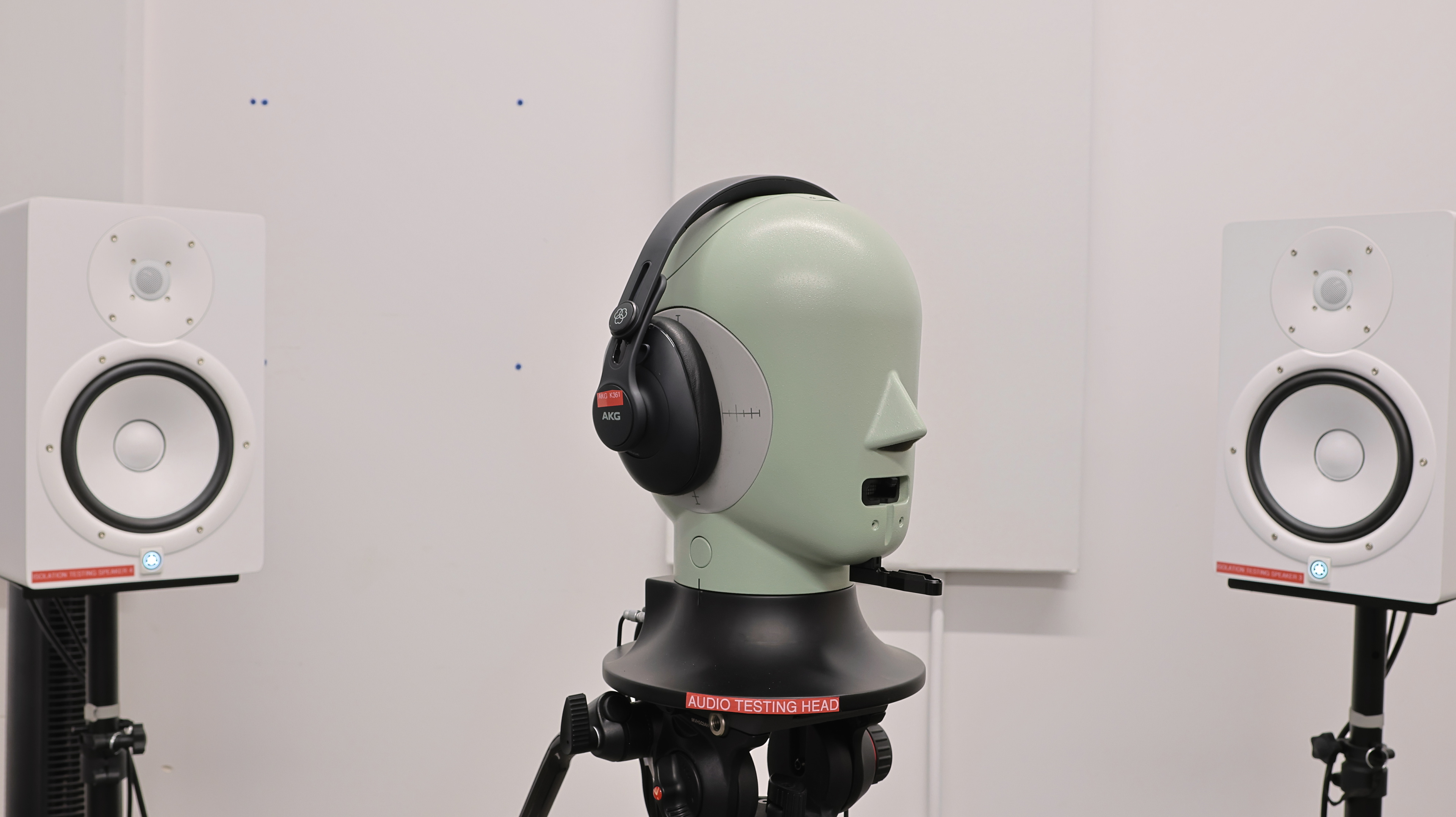
The AKG K361 have a warm and balanced sound signature. The tuning straddles the line between a more multi-purpose tuning like our target curve and the Harman IEM target curve (which isn't surprising, considering AKG and Harman are owned by the same company), while the top-end is a little more analytical, like the SoundGuys.com Studio Curve. The headphones inject a bit of extra high-bass than any of the reference frequency responses, which adds boominess. Their mid-range is relatively flat, allowing for clear and detailed reproduction of vocals and instruments. However, their treble fluctuates a bit, losing detail in the low treble, introducing sharpness in the upper region of the mid treble, and ultimately losing brilliance and sparkle past the upper range of the high treble. It's worth noting that sensitivity to the highest frequencies varies from person to person, so not everyone will notice these fluctuations in the top end.
These headphones also had issues consistently replicating their frequency response during testing— from session to session, you might experience less thumpy bass and more unpredictable treble.
We've created a downloadable folder of EQ settings you can use to match the frequency response of these headphones to some of the target curves found on our Graph Tool.
Their frequency response consistency is poor. The soft earpads and lighter clamping force contribute to difficulty in achieving a good seal, which impacts their ability to deliver a consistent sound across the audible range. This issue is especially apparent if you have long hair or wear glasses, which break the seal, resulting in a big roll-off in bass compared to the raw frequency response measurement.
These headphones follow our target curve remarkably well in the bass range. They have a slightly elevated response across most of the range, resulting in mixes that sound full-bodied and deliver satisfying thump. In tracks like Billie Eilish's Bad Guy, the rhythmic kick hits with noticeable weight, enhancing the track's rhythm and intensity without bleeding into the mid-range. However, their bass performance can be inconsistent—difficulty getting the right seal between listening sessions can lead to an underwhelming bass experience. It's worth taking the time to seat them so you don't get too much or too little bass.
The AKG K361's target compliance is fantastic in the mid-range. Their response is flat across the range, reproducing smooth mids with clear and detailed vocals and instruments.
The AKG K361 have very good treble target compliance. The treble range is slightly underemphasized and warm, but it still gets close to our target, with a shot of sparkle in the mid- to high-treble. A dip in the low- to mid-treble reduces the presence of vocals and instruments. However, their response is a bit uneven, so certain upper harmonic frequencies from cymbals can surprise you with sharpness.
Their peaks and dips performance is adequate. The headphones are mostly smooth in the bass and mid-range, with only minor peaks and valleys for even reproduction of bass guitar and keys. However, their treble has notable peaks and dips that can narrowly exaggerate harshness and sharpness, or dull detail and clarity, depending on the pitch.
The headphones have decent stereo mismatch performance. The L/R drivers are tightly matched, so each side sounds about the same volume. There is a little weighted frequency response and weighted phase mismatch. However, since these mismatches occur in the rather high treble frequencies, where there isn't much audio content and are approaching the thresholds of human hearing, these deviations aren't audible, so the stereo image is effectively preserved. These results are only valid with our pair and may differ from other units.
Their group delay is subpar. Due to the peak representing a delay in the low-bass and the dip in timing that follows in the mid-bass, bass frequencies can sound somewhat loose and a little messy.
These closed-back headphones' PRTF measurements are sub-par. While they interact with your outer ears' pinnae, the effect doesn't mimic the sense of space you'd experience with an angled reference monitor.
The AKG K361 have remarkable harmonic distortion performance. At 94 dB/SPL and 104 dB/SPL, each tested frequency remains clean and unadulterated with artifacts.
These headphones don't need an amp to achieve adequate listening levels, so you can plug the cable directly into your PC or console controller.
These are the settings used to test these headphones. Our results are only valid when used in this configuration.
The AKG K361 are over-ear headphones with a retro design similar to their sibling, the AKG K371. Their primarily plastic construction is finished in matte black, while their ear cups are styled with synthetic leather padding. They have an external sliding track for adjusting their fit, with the manufacturer's logo printed onto the hinges. Their ear cups are mounted to an articulated arm, so you can flip one of them to the side while you record a track.
The AKG K361 feel comfortable. These headphones are exceptionally lightweight for over-ear headphones and have a light clamping force, so you'll be able to wear them for longer listening sessions without fatigue. Their headband and plush cup padding distribute weight well and won't put pressure on those with glasses. That said, while their ear cups have good depth, they may feel too narrow for users with wider ears.
These headphones aren't very portable. While their hinges let you fold the ear cups upward into the headband, they still take up a fair amount of space. On the plus side, their detachable cable makes them easier to fold and pack up.
These headphones come with an okay carrying pouch. It's made of thin fabric with a soft interior and rough exterior. While the pouch will keep your headphones well contained with its cinch top, it won't protect your headphones from prolonged weather exposure or impacts.
The AKG K361 headphones have a decent build quality. Their construction is primarily plastic, which feels light and comfortable but slightly cheap. The ear cups are covered in soft, premium-feeling faux leather, while the headband padding feels more plasticky. The yokes are solid, and the input cable moves smoothly with the ear cups. Their cable is also detachable and has a locking mechanism to keep it secure. On the downside, the hinges attaching the ear cups to the headband aren’t very sturdy and can sometimes slip between locked positions.
These headphones have mediocre stability. While the clamping force keeps them in place during casual listening, if you're immersed in an energetic track and nod along to the music, the headband moves around a lot. However, they're unlikely to fall off unless you're running around or headbanging for a prolonged period. These headphones are also wired only, so their cable can get caught on obstacles, especially if you move around.
These headphones have sub-par noise isolation performance. They purely isolate passively, and don't have the lower-range mitigation provided by active noise cancelling systems. As expected, they don't do much to block out low frequency noise like footsteps from neighbors a floor above. However, they do manage to tackle higher frequency noise in the treble, like the squeaky recline of your office chair. Depending on your head shape and other factors that affect seal quality (like glasses), these headphones can perform differently in noise isolation, especially if you move around.
These headphones have poor noise isolation in common scenarios as well. For the same reasons mentioned in Noise Isolation - Full Range, these headphones don't tackle bassier noises like the thud of car and office doors slamming shut. They're also not great at handling ambient chatter in an airplane cabin or in a bullpen. Fortunately, their passive isolation does mitigate treble noise, like hissing breaks from large vehicles.
These headphones have good leakage performance. Most audio won't be very audible in the average home or office, with your closest neighbors hearing a thin-sounding replica of your favorite podcast or track if you have your volume fairly loud.
These cans are passively driven and have negligible latency. They also come with two detachable 1/16" TRS to 1/8" TRS cables at 3.01m (9.88 ft) and 1.18m (3.87 ft). The 1/16" jack goes into the headphones and has a unique locking mechanism; if you're shopping for an aftermarket solution, you'll need to make sure to snag a cable with a compatible lock. You also get a 1/8" TRS to 1/4" TRS adapter, making them compatible with pro gear and casual products alike.
Most PCs can drive these headphones without an amp via connection to your computer's headphone jack.
These headphones can be plugged into a PlayStation controller for audio output. However, you'll need an external microphone for audio input.
The AKG 361 can be plugged into an Xbox controller and be used for audio output. However, you'll need an external microphone for audio input.

